Fluid Inclusions Analyses Laboratory
- Home
- Instruments and Personnel
- Methods and Applications
- Projects and Scientific Interests
- Publications

Fluids (liquid, gas or supercritical fluid) present in the lithosphere during the history of the earth can be trapped in the form of small, generally microscopic, inclusions in minerals.
The most common fluids trapped in the inclusions are:
- aqueous solutions with variable salinity,
- volatile phases (mostly CO2, CH4 and N2 in different proportions)
- hydrocarbons
- aqueous solutions with variable salinity containing volatile phases and/or hydrocarbons.
The analyses of fluid inclusions can therefore provide fundamental information about the physical and chemical nature of the fluid present in the past in various geological environments. The main analytical method is microthermometry that is based on the temperatures at which phase changes occur within fluid inclusions. Fluid inclusion analyses are commonly applied in the study and exploration of ore deposits; in geothermal researches; in oil exploration; in metamorphic, magmatic and sedimentary petrology; in research on the relationships between fluid circulation and tectonic structures etc.

Fluid inclusions can be classified according to phases present at room temperature and the volumetric ratios between phases. A) Two-phase inclusion constituted by liquid and vapour, the inclusion is liquid-rich; B) Two-phase inclusion constituted by liquid and vapour, the inclusion is vapour-rich; C) Three-phase inclusion in which are present two immiscible liquids (Liquid 1: aqueous solution, Liquid 2: CO2) and a gaseous phase (consisting largely of CO2); D) Three-phase in which are present liquid, vapor and a solid (NaCl cube).

LFluid inclusions can be formed either during the growth of the host mineral (primary and pseudo-secondary inclusions) or after the complete crystallization of the host mineral (secondary inclusions). A) Primary Inclusions occurring along a growth zone of the host mineral, trapped within imperfections of the crystal formed during its growth; B) Pseudo-secondary Inclusions were trapped within fractures that formed in host crystal during its growth, in this case the fracture is completely contained in the host crystal as the latter continued its growth after fracture formation; C) Secondary Inclusions were trapped within fractures that formed in the host crystal after its growth, in this case the fracture containing the inclusions intercept the edge of the host crystal. The host mineral of the inclusions shown the photomicrographs is quartz.
INSTRUMENTS
The laboratory is equipped with the following apparatus for microthermometric analysis:
- Heating/freezing (-180/+600°C) Linkam THMSG 600 stage, mounted on a Leitz Ortholux microscope furnished with long-working distance Olympus objective lenses (20x, 50, 80x), and equipped with a liquid nitrogen cooling system (LNP93/2), a controller TMS93/1500, a LinkSys Software, and a video camera JVC TK-C1380 for digital image acquisition. Alternatively, a Linkam TS 1500 high temperature (up to 1500°C) stage can be mounted on the microscope.
- Heating / freezing (-180/+600°C) Linkam THMS600 stage, mounted on a Zeiss Axio Scope.A1 microscope furnished with 3 long-working distance Epiplan objective lenses (5x, 20x, 50x), and equipped with a Linkam STD-T95 controller and LINKPAD pump for water circulation, a Linkam THMS-LNP95 liquid nitrogen cooling system, an Axiocam ICC1 videocamera for digital microscopy, and a REL 4.8.2 AxioVision software, for acquisition and digital image processing, and drivers for the Linkam stage.
- Quartz disc containing synthetic fluid inclusions of different composition and density employed for stage thermocouple calibration and for didactic purpose.
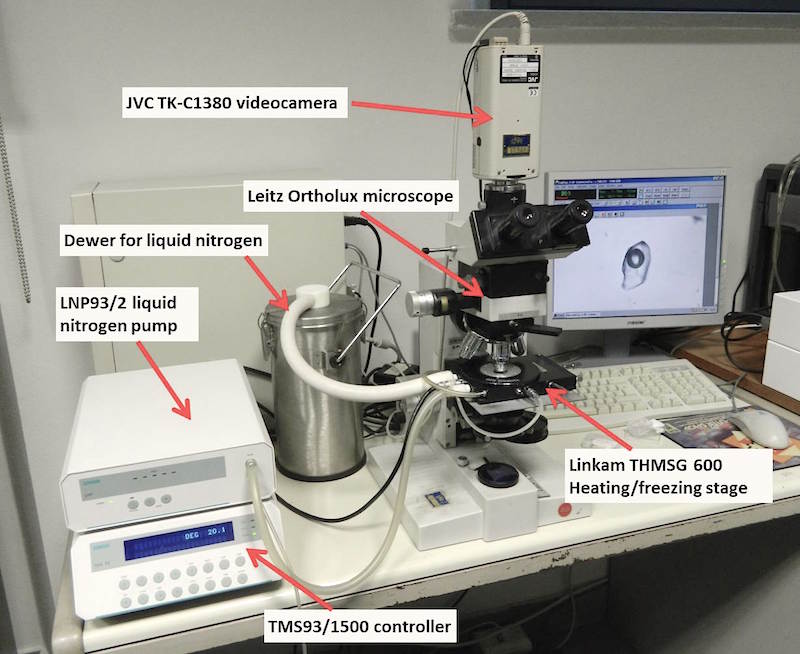
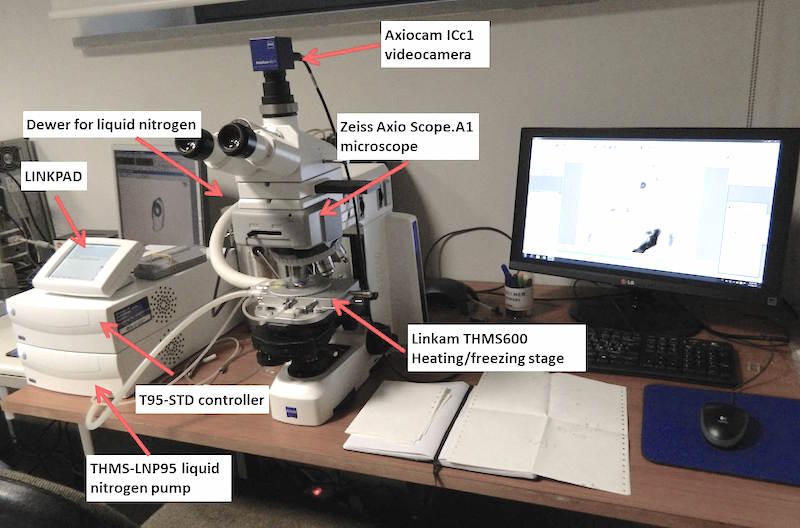
METHODS
Microthermometric analyses are at the base of all fluid inclusion study. Microthermometry is carried out by using a heating/cooling stage mounted on an optical microscope, trough which is possible to observe and record the temperature of phase changes that take place in the fluid inclusions during controlled thermal cycles. On the basis of the recorded temperatures it is possible to obtain information on some chemical-physical parameters of the trapped fluids, for example: the salinity and the molar volume of aqueous solutions, the presence of CO2 (and sometimes CH4 and/or N2) in the fluids, the molar volume of fluid inclusions containing exclusively CO2 or CH4 or N2. Furthermore, by integrating microthermometric data with data obtained for micro-Raman spectroscopy it is possible to obtain information on the composition and the molar volume of aqueous solutions containing volatile phases (CO2 and/or CH4 and/or N2).
APPLICATIONS
Studies of fluid inclusions are currently applied to multiple earth science fields including:
- ore deposits, either for the study of ore genesis and for mining exploration purposes;
- geothermal energy for the reconstruction of the evolution of geothermal systems and for thermometric purposes;
- oil exploration;
- sedimentary and metamorphic petrology;
- structural geology for research on the relationships between fluid flow and tectonic structures;
- gemology
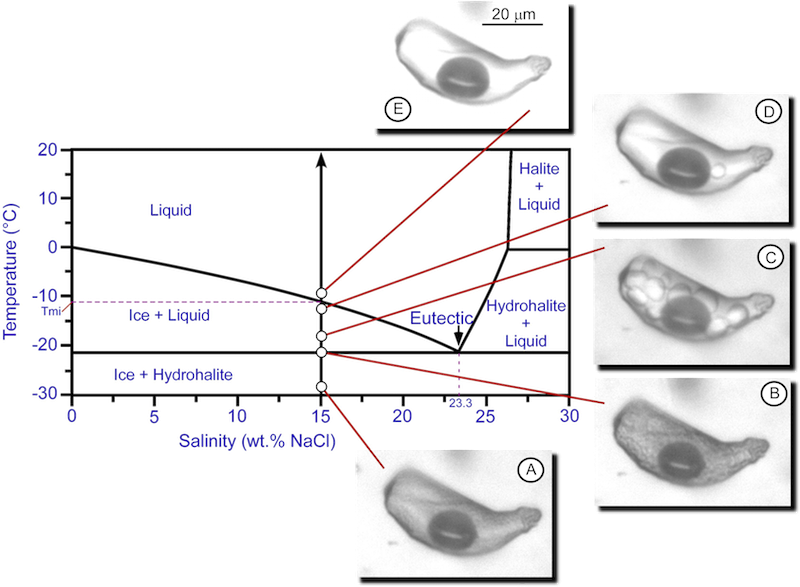
Salinity of fluid inclusions containing aqueous solutions not saturated at room temperature can be estimated on the basis of ice melting temperature if it is the last solid to melt. The salinity of fluid inclusions is conventionally expressed in "weight % of NaCl equivalent", that is the amount (in weight %) of NaCl which produces a lowering of the melting temperature of ice equivalent to that observed. The H2O-NaCl diagram and photomicrographs show some steps of the thermal cycle necessary for the measurement of the ice melting temperature of a two-phase, liquid-rich inclusion containing a saline solution in which NaCl is the main dissolved salt. The first step is to completely freeze the inclusions, this can be achieved by cooling to temperatures significantly below the freezing temperature of the solution. (A) The solids that formed upon freezing are ice and hydrohalite; (B) the inclusion is heated and the internal appearance change (is formed of the liquid) because of the total melt of hydrohalite at the eutectic temperature; (C) further temperature increase will produce the progressive melting of the ice: initially there are numerous ice crystals with rounded shape; (D) close to the temperature of final ice melting only a small ice crystal is present; (E) just above the temperature of ice melting only liquid and vapour phases are present. The last ice crystal melted at about -11°C corresponding to a salinity of 15 weight % of NaCl equivalent.
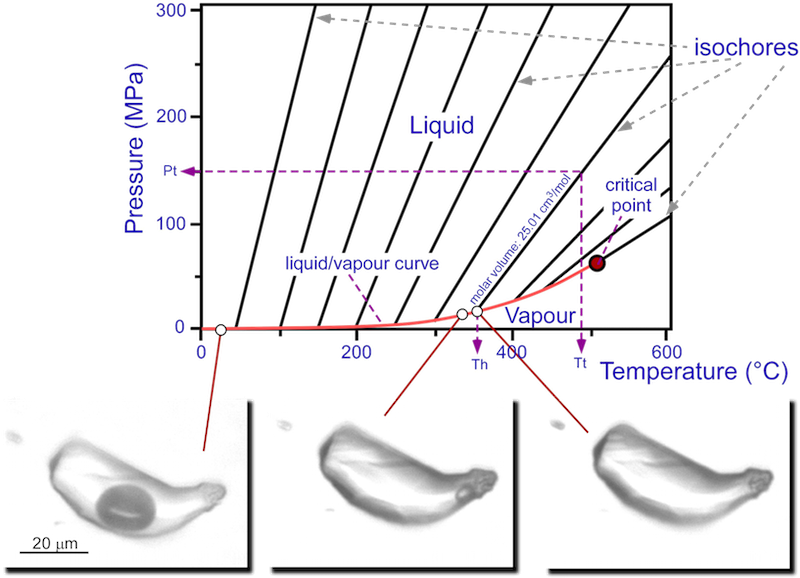
Fluid inclusions usually can be considered nearly isochoric systems (i.e. the changes of inclusion molar volume is negligible since its trapping). For inclusions containing saline solutions, once it is estimated solution salinity, it is also possible to determine the molar volume (and therefore the density) by observing the so-called homogenization temperature (Th), i.e. the temperature at which the inclusion becomes mono-phase during a heating cycle. The Pressure-Temperature diagram for the H2O-NaCl system for a concentration of 15 weight % of NaCl (after Bondar and Vytik (1994) in: Fluid Inclusions in Minerals: Methods and Applications, Virginia Polytechnic Institute, Blacksburg (1994), 117–130, modified) and photomicrographs illustrate some steps of the microthermometric analysis for the Th measurement of previous two-phase liquid-rich inclusion. (A) At room temperature the inclusion is constituted by a liquid phase and a vapor bubble and stay along the liquid/vapor curve of the saline solution; by increasing the temperature the size of the bubble decreases (the liquid expands), (B) shortly before the Th the bubble is rather small; (C) at Th the bubble disappears, and the inclusion is constituted only by the liquid phase. Then the fluid inclusion will follow the isochore starting from its Th if the temperature is increased. Each isochore is characterized by a molar volume then from Th it is possible to obtain the inclusion molar volume. The Th corresponds to the inclusion trapping temperature (Tt) only if it has been trapped along the liquid/vapor curve, i.e. during fluid immiscibility conditions (for example during boiling). On the other hand if the fluid inclusion was trapped in the liquid field it is necessary to know the pressure of entrapment (Pt) in order to estimate the fluid entrapment temperature. For example if Pt for the examined inclusions deduced on the basis of overburden load estimates was about 150 MPa the Tt was about 490°C. Whereas, if the temperature of the fluid is known (for example from independent geothermometers) Pt can be estimated.
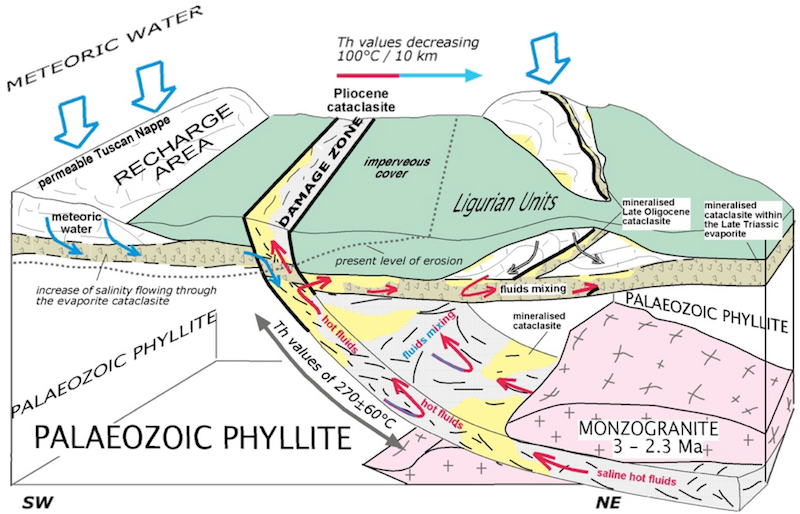
PROJECTS
- IMAGE (EU-FP7) project (in progress) is aimed at exploring and evaluating geothermal reservoirs using a multidisciplinary approach which also includes the understanding of the processes and properties of supercritical geothermal reservoirs through the study of fossils exhumed systems similar to active systems. The purpose of fluid inclusion studies is the physical and chemical characterization of the fluids circulating in exhumed fossil hydrothermal reservoir.
- DESCRAMBLE (EU-Horizon 2020) project (in progress), the main goal of this project is to drill in the continental crust, at geothermal supercritical conditions, and to test and demonstrate innovative drilling techniques that can control gas emissions, aggressive environment and high temperature and pressure conditions of deep fluids. As test site was chosen the geothermal field of Larderello. The study of fluid inclusions is aimed at the reconstruction of physical and chemical characteristics of the deep fluids presumably present at the target depth.
- CNR-TUBITAK joint project (2014-2015): Integrated approach to characterize the structural setting and the related fossil geothermal system along the northern boundary of the Quaternary Denizli Basin (Turkey). The purpose of the project was to understand the relationships between tectonic structures and hydrothermal fluids that generated numerous travertine deposits in the area. Through the study of fluid inclusions and isotopic analysis it was possible to characterize the temperature and the origin of the fluids associated with structures responsible for travertine deposition.
SCIENTIFIC INTEREST
Applications of fluid inclusions to:
- Studies on fluid evolution and water-rock interaction processes in geothermal fields.
- Researches on the genesis of mineralization and hydrothermal ore deposits.
- Thermo-barometric reconstructions of metamorphic and contact-metamorphic complexes.
- Studies on the relationship between tectonic structures and fluid flow.
- Researches on natural analogues of CO2 mineral sequestration.
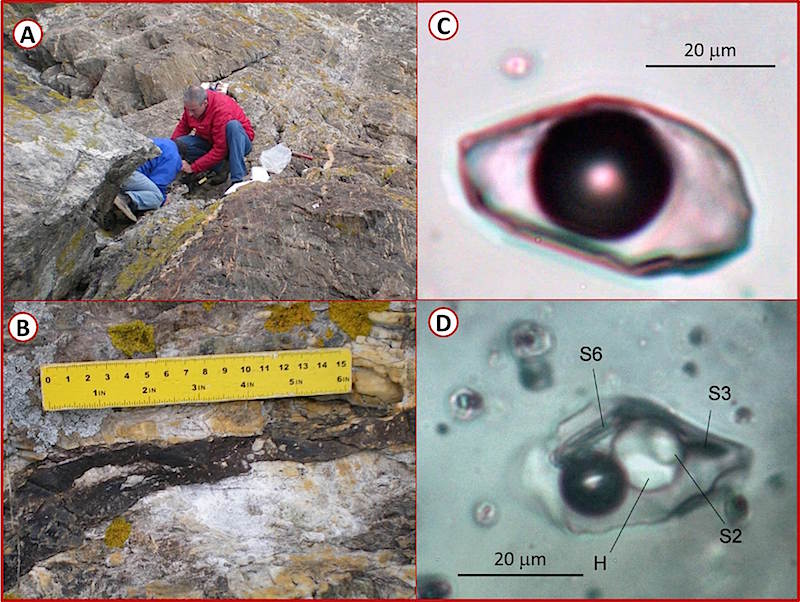
One of site studied in the frame of the IMAGE project is the quartz and tourmaline veins system of in Mount Calamita (Elba Island, Italy). This represents a fossil exhumed hydrothermal system similar to what would be in the Larderello geothermal field below the currently exploited reservoir. (A) Sampling of quartz-tourmaline veins; (B) Detail of a quartz-tourmaline vein; (C) Two-phase inclusion (liquid + vapor) trapped in quartz; (D) Multi-phase inclusion (liquid + vapor + halite (H) + 3 solids (S2, S3, S6)) in quartz.
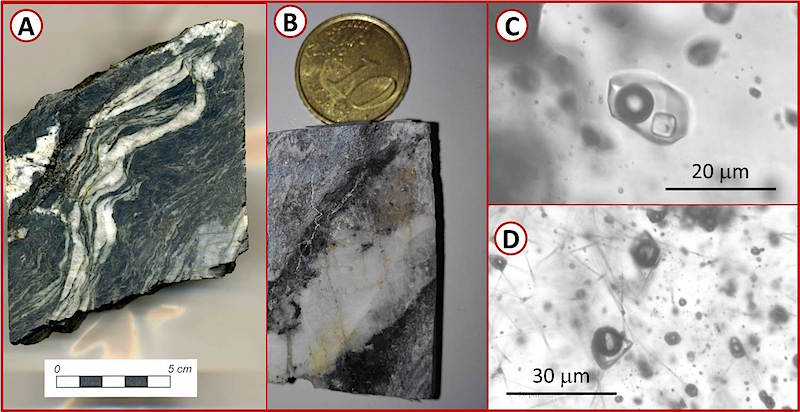
Studies on samples characterized by the presence of tourmaline from the deep part of the Larderello geothermal field are ongoing for the DESCRAMBLE project. These samples contain fluid inclusions that were trapped at depths greater than at present (the system is exhumed). Fluid inclusion studies will furnish some information on chemical-physical parameters of the fluids that will be likely encountered during the drilling at super-critical conditions. (A) and (B) Core sample containing quartz-tourmaline vein from a Larderello geothermal object of the study of the project; (C) Two-phase inclusion (liquid + vapor) in the quartz vein; (D) three-phase inclusion (liquid + vapor + halite) in quartz.

During the CNR - TUBITAK joint project banded travertine veins were samples in the northern edge of Denizli basins in order to analyze the fluid inclusions contained in calcite of the veins. (A) Travertine deposit object of studies and sampling; (B) Pseudo-secondary bi-phase (liquid + vapor) liquid-rich inclusions and mono-phase (liquid) inclusions in calcite; (C) Two-phase (liquid + vapor) liquid-rich inclusion in calcite.
SELECTED PUBLICATIONS
- Brogi, A., Alçiçek, M.C., Yalçiner, C.T., Capezzuoli, E., Liotta, D., Meccheri, M., Rimondi, V., Ruggieri, G., Gandin, A., Boschi, C., Büyüksaraç, A., Alçiçek, H., Bülbül, A., Baykara, M.O., Shen, C.-C. (2016) Hydrothermal fluids circulation and travertine deposition in an active tectonic setting: Insights from the Kamara geothermal area (western Anatolia, Turkey). Tectonophysics, 680, 211–232.
- Rimondi, V. , Costagliola, P., Ruggieri, G., Benvenuti, M., Boschi, C., Brogi, A., Capezzuoli, E., Morelli, G., Gasparon, M., Liotta, D. (2016) Investigating fossil hydrothermal systems by means of fluid inclusions and stable isotopes in banded travertine: an example from Castelnuovo dell’Abate (southern Tuscany, Italy). International Journal of Earth Sciences, 105, 659-679.
- Bicocchi G., Tassi F., Bonini M., Capecchiacci F., Ruggieri G., Buccianti A., Burgassi P., Vaselli O. (2013) The high pCO2 Caprese Reservoir (Northern Apennines, Italy): Relationships between present- and paleo-fluid geochemistry and structural setting. Chemical Geology 351, 40–56.
- Gasparrini M., Ruggieri G., Brogi A. (2013 ) Diagenesis versus hydrothermalism and fluid-rock interaction within the Tuscan Nappe of the Monte Amiata CO2-rich geothermal area (Italy). Geofluids, 13, 159–179.
- Liotta D., Ruggieri G., Brogi A., Fulignati P., Dini A., Nardini I. (2010) Migration of geothermal fluids in extensional terrains: the ore deposits of the Boccheggiano-Montieri area (southern Tuscany, Italy). International Journal of Earth Sciences, 99, 623-644.
- Mazzarini F., Isola I., Ruggieri G., Boschi C. (2010) Fluid circulation in the upper brittle crust: Thickness distribution, hydraulic transmissivity fluid inclusion and isotopic data of veins hosted in the Oligocene sandstones of the Macigno Formation in southern Tuscany, Italy. Tectonophysics, 493, 118–138.
- Boiron M.C., Cathelineau M., Ruggieri G., Jeanningros A., Gianelli G., Banks D.A. (2007) Active contact metamorphism and CO2-CH4 fluid production in the Larderello geothermal field (Italy) at depths between 2.3 and 4 km. Chemical Geology, 237, 303-328.
- Dini A., Di Vincenzo G., Ruggieri G., Rayner J., Lattanzi P. (2005) Monte Ollasteddu, a new gold discovery in the Variscan basement of Sardinia (Italy): first isotopic (Ar-40-Ar-39, Pb) and fluid inclusion data. Mineralium Deposita, 40, 337-346.
- Montomoli C., Ruggieri G., Carosi R., Dini A., Genovesi M. (2005) Fluid source and pressure-temperature conditions of high-salinity fluids in syn-tectonic veins from the Northeastern Apuan Alps (Northern Apennines, Italy). Physics and Chemistry of the Earth, 30, 1005-1019.
- Ruggieri G., Giolito C., Gianelli G., Manzella A., Boiron M.C. (2004) Application of fluid inclusions to the study of Bagnore geothermal field (Tuscany, Italy). Geothermics, 33, 675-692.
- Vaggelli G., Francalanci L., Ruggieri G., Testi S. (2003) Persistent polybaric rests of calc alkaline magmas at Stromboli volcano, Italy: pressure data from fluid inclusions in restitic quartzite nodules. Bulletin of Volcanology, 65, 385-404.
- Maineri C., Benvenuti M., Costagliola P., Dini A., Lattanzi P., Ruggieri G., Villa I.M. (2003) Sericitic alteration at the La Crocetta deposit (Elba island, Italy): interplay between magmatism, tectonics and hydrothermal activity. Mineralium Deposita, 38, 67-86.
- Montomoli C., Ruggieri G., Boiron M.C., Cathelineau M. (2001) Pressure fluctuation during uplift of the northern Apennines (Italy): a fluid inclusions study. Tectonophysics, 341, 121-139.
- Ruggieri G., Gianelli G. (1999) Multi-stage fluid circulation in a hydraulic fracture breccia of the Larderello geothermal field (Italy). Journal of Volcanology and Geothermal Research, 90, 241-261.
- Ruggieri G., Cathelineau M., Boiron M.C., Marignac C. (1999) Boiling and fluid mixing in the chlorite zone of the Larderello geothermal system. Chemical Geology, 154, 237-256.
- Gianelli G., Mekuria N., Battaglia S., Chersicla A., Garofalo P., Ruggieri G., Manganelli M., Gebregziabher Z. (1998) Water-rock interaction and hydrothermal mineral equilibria in the Tendaho geothermal system. Journal of Volcanology and Geothermal Research, 86, 253-276.
- Gianelli G., Ruggieri G., Mussi M. (1997) Isotopic and fluid-inclusion study of hydrothermal and metamorphic carbonates in the Larderello geothermal field and surrounding areas, Italy. Geothermics, 26, 393-417.